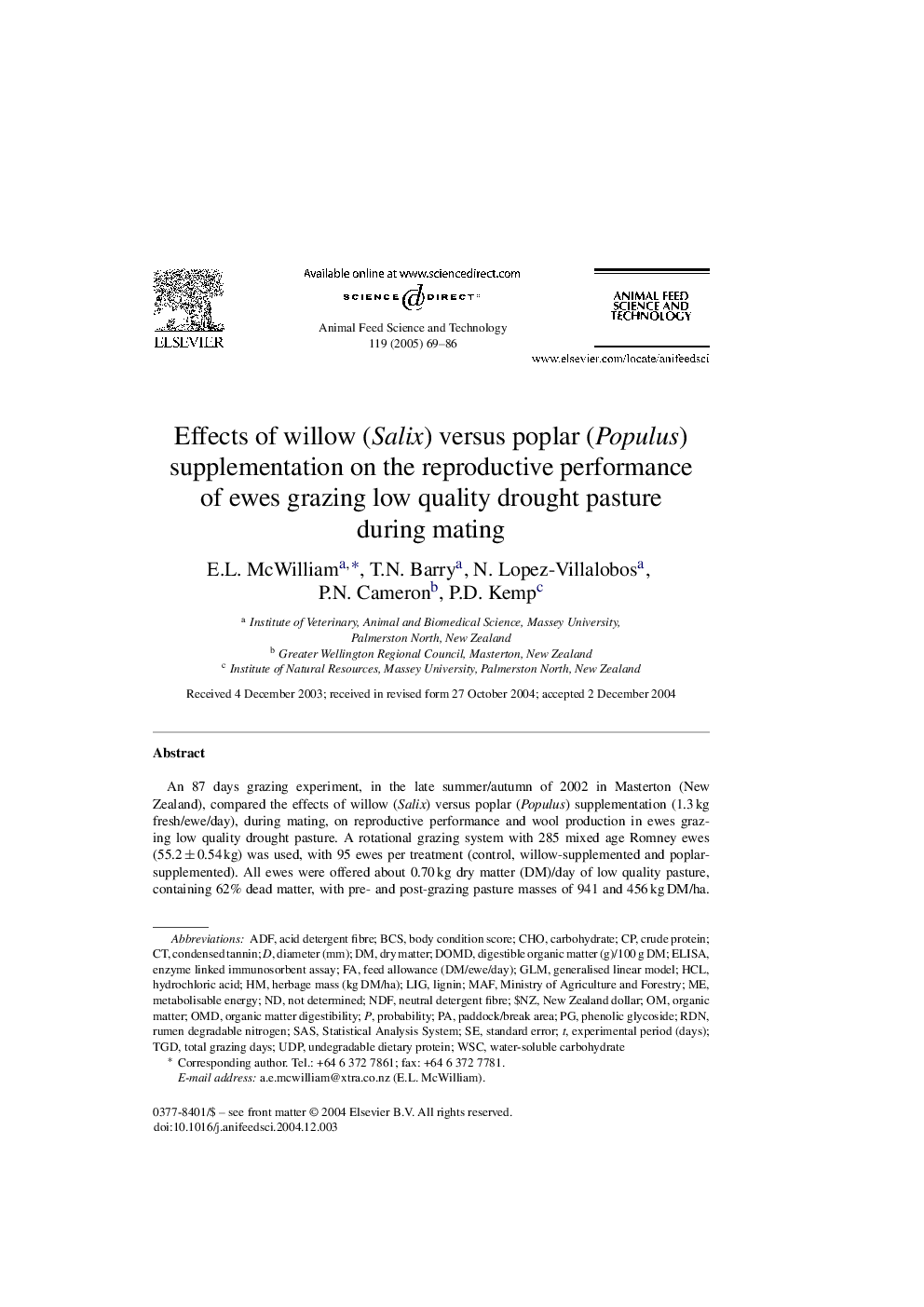| Article ID | Journal | Published Year | Pages | File Type |
|---|---|---|---|---|
| 8973895 | Animal Feed Science and Technology | 2005 | 18 Pages |
Abstract
An 87 days grazing experiment, in the late summer/autumn of 2002 in Masterton (New Zealand), compared the effects of willow (Salix) versus poplar (Populus) supplementation (1.3 kg fresh/ewe/day), during mating, on reproductive performance and wool production in ewes grazing low quality drought pasture. A rotational grazing system with 285 mixed age Romney ewes (55.2 ± 0.54 kg) was used, with 95 ewes per treatment (control, willow-supplemented and poplar-supplemented). All ewes were offered about 0.70 kg dry matter (DM)/day of low quality pasture, containing 62% dead matter, with pre- and post-grazing pasture masses of 941 and 456 kg DM/ha. Pasture consumed was typical of drought pasture; 571 g neutral detergent fibre (NDF)/kg DM, 0.540 organic matter digestibility (OMD). Both the willow and poplar diets selected were higher in OMD and metabolisable energy (ME) and had a higher ratio of readily fermentable carbohydrate (CHO) to structural CHO, than the pasture diet selected. Willow contained higher concentrations of condensed tannin (CT; 52 g/kg versus 19 g/kg; P < 0.001) and total phenolic glycosides (34 g/kg versus 17 g/kg; P < 0.001) than poplar. The concentration of total phenolic glycosides increased curvilinearly over time with peak values between 51 and 61 days, corresponding to the mating period. Reproductive rate was low in the control ewes (133 lambs born/100 ewes mated), with willow supplementation reducing live weight (LW) loss (â86 g/day versus â103 g/day) and increasing ewe reproductive rate by 15, 17, 21 and 20% units at ultrasound scanning, lambing, docking and weaning, respectively, through an increase in the proportion of multiple pregnancies (fecundity). Poplar supplementation had no affect on reproductive rate, probably due to contamination with poplar leaf rust (Melampsora larici-populina), which may produce an unknown oestrogenic substance. There were no treatment effects on wool production and only small treatment effects on the LW of single- and twin-born lambs at birth and weaning. Willow tree trimmings are a beneficial supplement for increasing the reproductive rate of ewes grazing drought pasture during the pre-mating and mating periods and they may be superior to poplar tree trimmings, due to higher concentrations of both CT and phenolic glycosides. Willow supplementation increased the intakes of DM and ME, but this did not explain all of the increase in reproductive rate. The increased concentration of total N, CT, phenolic glycosides and water-soluble CHO in the diet of supplemented ewes would be likely to increase amino acid absorption and this may explain the remainder of the increase in ewe reproductive rate from willow supplementation.
Keywords
SASDrought feedingdigestible organic matter (g)/100 g DMDOMDOMDtgDNDFUDPRDNADFWSCMAFGLMHClLIGenzyme linked immunosorbent assayProbabilityhydrochloric acidacid detergent fibremetabolisable energyChoCondensed tanninELISAReproductionstandard errorBCsStatistical Analysis Systemneutral detergent fibreLigninorganic matterdry matterGeneralised Linear Modelnot determinedBody condition scoreOrganic matter digestibilitycrude proteinCarbohydrateWater-soluble carbohydratePhenolic glycoside
Related Topics
Life Sciences
Agricultural and Biological Sciences
Animal Science and Zoology
Authors
E.L. McWilliam, T.N. Barry, N. Lopez-Villalobos, P.N. Cameron, P.D. Kemp,
